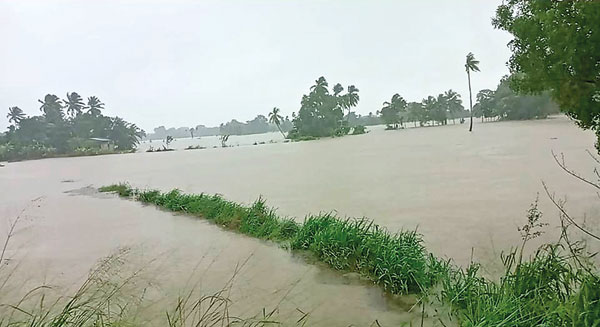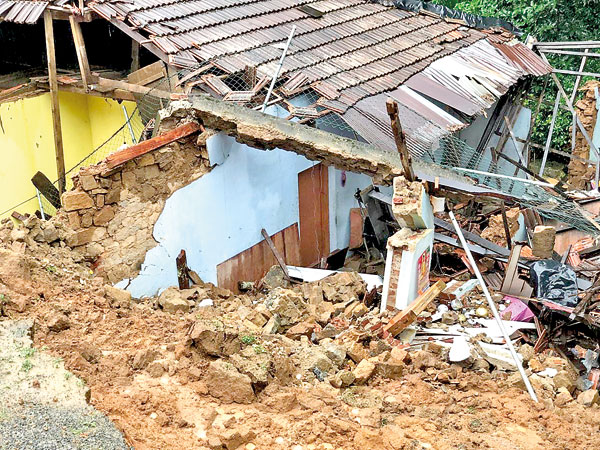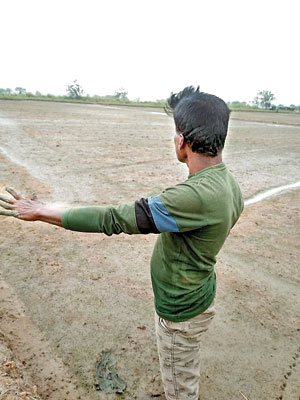News
After the floods; the task of compensation begins
View(s):- Focus on plight faced by farmers whose crops have been destroyed or damaged
By Sandun Jayawardana
While the disaster situation caused by the adverse weather conditions is now over, focus has shifted to damage assessment and providing compensation. In the aftermath of the disaster, the plight faced by farmers whose crops have been destroyed or damaged has taken centre stage.
The vast majority of those who have been displaced owing to the adverse weather have now returned to their homes. According to figures released by the Disaster Management Centre (DMC) last morning, just 1463 persons from 432 families remained at 17 safe locations.

Farmers who have suffered damage to their crops have been urged to file damage claims by December 10 Pix by Gnanasiri Hettiarachchige
DMC officials said teams from Divisional Secretariats are currently assessing property damage to provide compensation. As per the DMC’s figures, 97 houses had been destroyed while 1789 others had suffered partial damage due to adverse weather. A total of 65 small and medium enterprises had been damaged while 16 instances had been recorded of damage to critical infrastructure.
Compensation claims for farmers whose crops have been affected by the adverse weather is being handled by the Agricultural and Agrarian Insurance Board (AAIB). Its Chairman Pemasiri Jasingarachchi urged farmers who have suffered damage to their crops to file damage claims by December 10.
Mr Jasingarachchi told the Sunday Times that teams of officials have been in the field over the past few days assessing the damage to crops in the affected areas. Farmers whose crops have been affected can report the damages to their local Agrarian Development office. Mr Jasingarachchi noted that damage assessments involve several related agencies such as the Department of Agrarian Development and the Mahaweli Authority.

As per DMC, 97 houses are destroyed while 1,789 suffered partial damage Pic by Mahesh Keerthiratne
Officials estimate that about 300, 000 acres of cultivated lands had been inundated. About 25% of these flooded lands have suffered damage, Mr Jasingarachchi noted.
He added under the existing circular farmers who have suffered damage to their crops can receive a maximum amount of Rs. 40, 000 per acre as compensation. Compensation is awarded based on three stages of crop growth. To qualify for the maximum amount, the crops must have been in the final three months prior to harvesting. Compensation will be lesser for damage sustained to crops that were more than three months from harvesting when they were impacted by adverse weather.

In areas close to rivers and tanks, floods have left behind large swathes of sand in paddy fields and fields planted with other crops Pic by Nimal Jayaratne
In areas close to rivers and tanks, floods have left behind large swathes of sand in paddy fields and fields planted with other crops. Farmers in these areas have been requesting authorities to take measures to remove the sand from their fields to enable them to try and cultivate their fields again.
The issue over compensation for farmers was raised in Parliament as well. The House held an adjournment debate on the disaster situation on Wednesday where the subject was raised by several MPs who spoke.
Hambantota District Sri Lanka Podujana Peramuna (SLPP) MP D.V. Chanaka said that the maximum compensation of Rs. 40, 000 per acre was completely inadequate. “In areas like Hambantota some farmers have paddy fields that are not more than 2.5 acres. There are even fields that are just 1 acre. In most areas of the country, people only cultivate two seasons. As such, they must survive six months from that paddy field over one season. If the compensation for a 2.5 acre paddy field is Rs. 40, 000, the farmer will only receive Rs. 100, 000 for the entire field. If we are to divide this by six, the farmer will only receive Rs. 16, 000 a month. Then, his entire family must survive on Rs. 16, 000 a month,” he pointed out.
Mr Chanaka noted that if a farmer only had a one acre paddy field, he must survive on Rs. 5500. He asked the government if a family can survive a month on Rs. 16, 000 or Rs. 5500. He recalled that Deputy Minister of Agriculture Namal Karunaratne, who was a long-time activist for farmers’ rights, had once insisted that even Rs. 100, 000 an acre was not enough as compensation.
Deputy Minister Namal Karunaratne explained that the circular regarding the Rs. 40, 000 per acre compensation also came about due to struggles conducted by activists such as himself. “2016 recorded the lowest harvest in the country’s recent history owing to a massive drought. Given that situation, farmers waged a campaign for compensation and we led that struggle,” he noted, adding that many farmers’ activists who led that struggle are government MPs today. “It was thanks to our struggle that the circular stipulating the Rs. 40, 000 per acre amount as compensation for crop damage was issued in 2017,” said the deputy minister.
Mr Karunaratne said the Rs. 40, 000 per acre compensation was the maximum that can be given under the present law. “This is not enough. It must change. We can discuss this in the future and make a decision,” he emphasised.
He added that the incident Mr Chanaka referred to about him demanding Rs. 100, 000 per acre as compensation stemmed from an incident where 65, 000 acres of paddy land in Udawalawa was destroyed when authorities refused to release water for cultivation despite the necessary water being available at the Samanalawewa reservoir. “We had to erect a stage in Embilipitiya town and engage in a massive protest. We had to undertake protest marches. We won that struggle in the end as they released the water they initially claimed they did not have.”
He said the Rs. 100, 000 per acre they demanded had been from the personal funds of government MPs because the destruction that was caused was not due to a natural disaster, but a crime committed against the farmers by the then government.
The best way to say that you found the home of your dreams is by finding it on Hitad.lk. We have listings for apartments for sale or rent in Sri Lanka, no matter what locale you're looking for! Whether you live in Colombo, Galle, Kandy, Matara, Jaffna and more - we've got them all!

